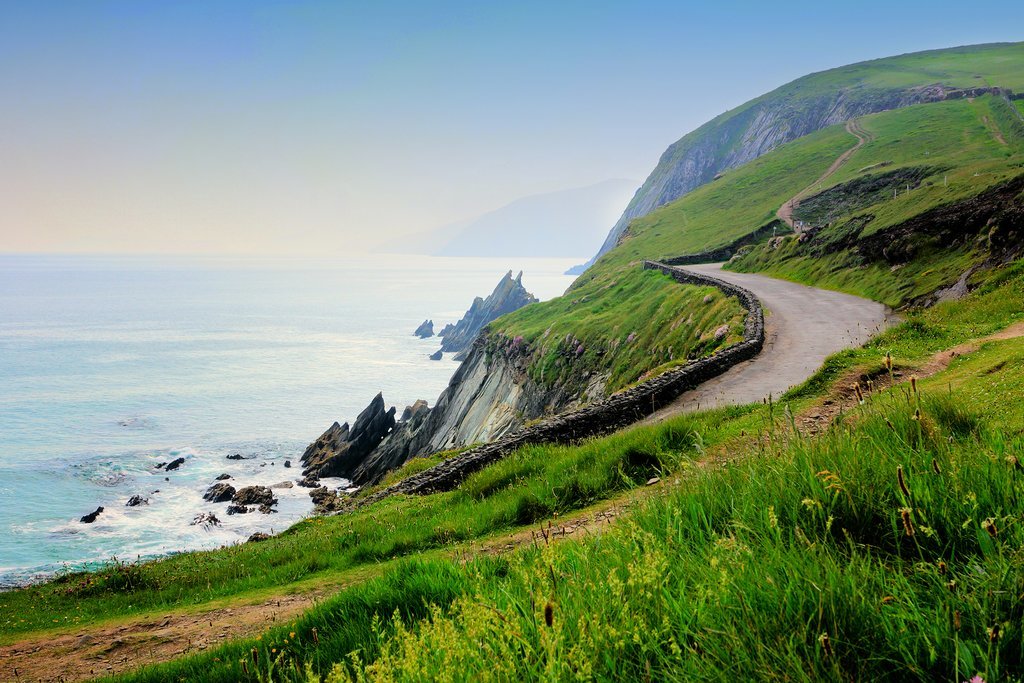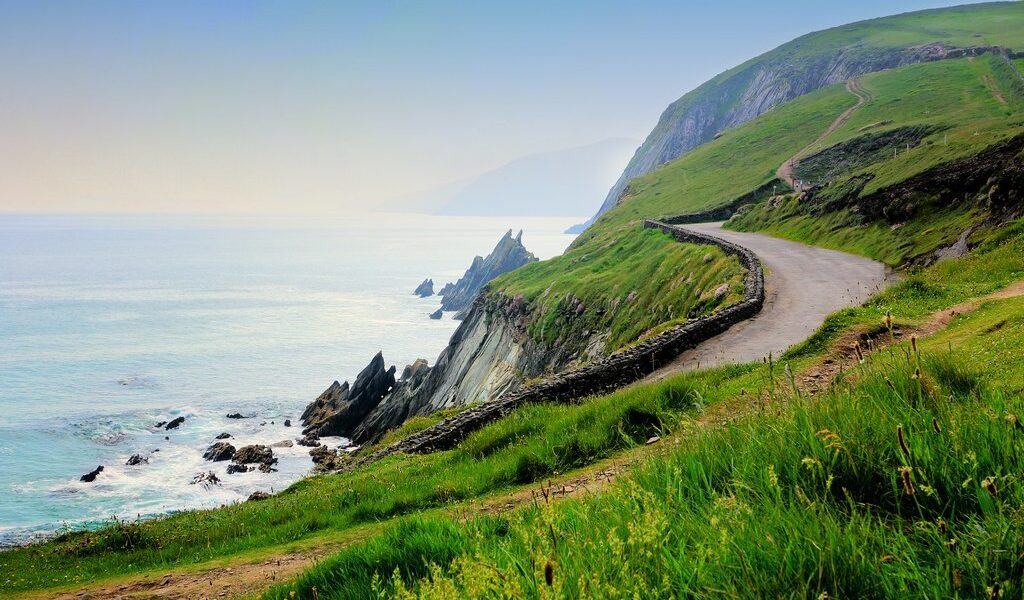
Spring may take a while to come to Ireland, as chilly, rainy weather is as slow to clear as the country is in coming back into action after a winter’s break that has seen many hotels, restaurants, and attractions outside the big cities close completely. But two big festivities toward the end of the month, St Patrick’s Day and Easter bring Ireland back into life with a bang, while the increasing appearance of the sun means visitors can enjoy at least a little of the outdoor activities now on offer.
Ireland in March: Travel Tips, Weather, and More (Expanded Edition)
Weather in Ireland in March
Ireland, while geographically compact, experiences a weather system that is far from uniform. Although specific regional distinctions might be subtle, the country as a whole undergoes a noticeable transition in March. This month often witnesses a dynamic interplay of weather fronts sweeping across the landscape. The prevailing pattern involves a gradual retreat of the wet and windy conditions that characterize the preceding months, giving way to a more temperate and agreeable climate.
While March signifies an improvement in the weather, it’s essential to understand that the transition is not always seamless. Temperatures do begin to climb, regularly reaching double-digit Celsius figures. However, the weather in Ireland in March is characterized by a persistent “tug-of-war” between unfavorable and pleasant conditions. Rain showers and strong winds remain a frequent occurrence, often interspersed with periods of calm and sunshine. This variability can contribute to a feeling of distinct chilliness throughout much of the month. It is important to note that March typically sees the lowest water temperatures of the year. If you plan on engaging in water activities such as surfing, diving, or swimming, it is essential to take precautions due to the cold.
Killarney & Southwest Ireland: A Microclimate?
Interestingly, despite Ireland’s generally unpredictable weather, the Killarney and Southwest Ireland region often presents a slightly different picture. This area tends to experience lower average rainfall compared to other parts of the country. With an average of just 3.3 inches (84 mm) of rainfall, March ranks as the sixth driest month of the year in this region. However, the number of rainy days in March is still relatively high, suggesting that the rainfall is characterized more by frequent bouts of drizzle than by intense downpours.
Despite this generally drier trend, it is still important to prepare for chilly weather. While the region tends to be warmer and sunnier than other areas of Ireland, average temperatures in Killarney typically range from 43°F to 52°F (6°C to 11°C). Water temperatures along the coastline remain at their coldest point during this time of year. Therefore, even in the relatively milder Southwest, a degree of caution is advised when taking to the seas.
Dublin & Eastern Ireland: City Weather Dynamics
In the Dublin and Eastern Ireland region, temperatures experience a significant uptick in March. Average highs of around 50°F (10°C) are commonly expected in Dublin. The city also benefits from an average of four daily hours of sunshine, a figure only surpassed by the months of April through August. However, this increase in sunshine is counterbalanced by a high number of rainy days, with an average of 25 days experiencing rainfall.
As a result, the weather in Dublin and Eastern Ireland during March is characterized by a high degree of changeability. When the sun is shining and the rain subsides, the weather can be quite pleasant. However, overcast conditions and rainfall can quickly transform the atmosphere, leading to less appealing conditions. Visitors to this region should prepare for a wide range of weather conditions and pack accordingly.
Belfast & Northern Ireland: A Late Spring
Belfast and Northern Ireland often experience the slowest transition to spring weather. With average air temperatures being the lowest in the country during March, and rainfall at its second-highest level of the year (3.14 inches/80 mm), this region may be the last to see the arrival of milder weather. Despite this, even here, the average daily hours of sunshine are gradually increasing, albeit at a slower pace compared to other parts of Ireland. Those visiting Belfast and Northern Ireland in March should be prepared for cooler temperatures and frequent rainfall, while keeping an eye out for increasingly longer and sunnier days.
Crowds and Costs in Ireland in March
March marks the end of Ireland’s traditional off-season. As the weather improves and St Patrick’s Day and Easter celebrations draw closer, both locals and travelers begin to venture out and explore the country’s attractions. Many hotels, restaurants, and tourist services, such as boat tours, begin to reopen after the winter months.
It’s important to be aware that prices for accommodation and services can increase, particularly during the St Patrick’s Day and Easter holidays. Major cities like Dublin, Galway, and Cork, which may be relatively quiet at other times, can quickly become fully booked during these peak periods. However, even with these price increases, accommodation and other services remain comparatively more affordable than during the peak summer season. For the most part, March is still considered a shoulder season, offering a balance between lower prices and pleasant weather.
Where to Go in Ireland in March
Planning your itinerary for a trip to Ireland in March depends on your priorities and your tolerance for unpredictable weather. Here are some suggestions for different regions of the country.
Killarney & Southwest Ireland: Towns and Coastal Wonders
In the early part of March, when the weather can still be somewhat wintry, it’s a good idea to base yourself in larger towns and cities like Galway, Killarney, Cork, and Tralee. This strategy allows you to easily access urban amenities and activities while still being able to take advantage of any breaks in the weather to explore the surrounding countryside or coast.
Near Killarney, a visit to Killarney National Park, Ireland’s oldest national park, is highly recommended. Even in March, the park offers plenty of opportunities for enjoyment. Muckross House & Gardens, a beautiful stately home located in the heart of the park, provides a sheltered activity. Other park attractions, such as the historic Ross Castle, typically reopen to the public after the winter closure in March.
Another must-see attraction is the Rock of Cashel, one of Ireland’s most important ancient sites. This historic fortress was once the seat of power for Irish royalty. Today, visitors can explore its medieval ruins and enjoy the beautiful riverside and woodland walks surrounding the site.
As the weather improves, take advantage of the brilliant light that illuminates the coastline during this time of year. Consider a coastal walk along the iconic Cliffs of Moher, or explore the clifftop walking trails near Galway. For a longer trek, the Dingle Way in Kerry offers breathtaking views of the rugged coastline.
Dublin & Eastern Ireland: City and Mountain Escapes
Dublin holds a unique charm in March, especially when the weather is less than ideal. It’s also the most atmospheric place to celebrate St Patrick’s Day. While in Dublin, visit attractions such as the Jameson Whiskey Distillery or the Guinness Storehouse. Learn about the history of Irish emigration at the Irish Emigration Museum, or explore historic sights like Trinity College.
However, Dublin also offers plenty of outdoor attractions, such as the River Liffey and several beautiful parks. If the weather is clear, consider hiking a section of the Wicklow Way, which meanders through the scenic Wicklow Mountains south of Dublin.
Belfast & Northern Ireland: History and Coastal Hikes
Focus on city destinations when visiting Northern Ireland in March. The weather in the north is often cold and wet for much of the month. Belfast, the capital of Northern Ireland, is the best place to be during inclement weather. This fascinating city is rich in recent history, boasts sophisticated museums, and offers a vibrant culinary scene. Historic attractions like Belfast Castle and museums such as the Ulster Museum, which showcases 9,000 years of Irish history, and Titanic Belfast, dedicated to the famous ship, are great options.
If the weather allows, explore the beautiful landscapes outside the city. The Causeway Coast Path passes by the UNESCO-listed Giant’s Causeway, a stunning natural formation of hexagonal basalt columns along the coast. The Ulster Way, a 636-mile (1,024-km) loop through Northern Ireland, is one of the UK’s longest hiking routes. A particularly scenic section is the Lough Bradan-Gortin stage, offering panoramic views.
What to Do in Ireland in March
Regardless of which part of Ireland you are visiting, there are plenty of activities to enjoy in March.
Killarney & Southwestern Ireland: Pubs, Parks, and Surfing
Given the unpredictable weather, it’s often best to stick to the larger towns and cities for much of the month. Celebrate St Patrick’s Day in a cozy traditional pub in Killarney, Galway, or Cork. Explore Killarney National Park, which offers options for both good and bad weather, such as Muckross House & Gardens, Ross Castle, and various woodland, lake, and island hikes.
Surfing is particularly good in the Donegal and Sligo areas during March. If the weather is favorable, consider tackling some of the region’s many hiking trails. The Dingle Way and Kerry Way combine the best of the rugged coastline and green, mist-covered mountains.
Dublin & Eastern Ireland: City Culture and Mountain Trails
In addition to Dublin’s historic and cultural attractions, March offers a chance to venture into the nearby countryside before the summer crowds arrive. Within the city, you can kayak down a section of the River Liffey.
For a hike close to the city’s pubs, try the Dublin Literary Pub Walk. Just outside Dublin, the Wicklow Way offers a scenic escape. Popular sections include the Marlay Park-Enniskerry route, ending in what is considered Ireland’s most charming village, and the Enniskerry-Roundwood trail, which passes by the spectacular Powerscourt Waterfall.
Belfast & Northern Ireland: History, Food, and Coastal Walks
Exploring Northern Ireland’s history, particularly at the Ulster Museum in Belfast, provides a fascinating escape from the frequent rains. The city’s food and drink scene is also worth exploring. Belfast boasts three Michelin-starred restaurants and the Victorian-era St George’s Market, which is filled with food and local crafts. Hiking on long-distance trails like the Causeway Coast Way becomes increasingly possible on sunnier days in March.
Events in March
Ireland is known for its lively events and celebrations, particularly in March.
**St Patrick’s Day, country-wide**. Celebrated on March 17th, St Patrick’s Day is the official day of Ireland’s patron saint. Many towns and cities host celebrations throughout March. Expect parades, live music, and plenty of socializing.
**Easter Festivities, country-wide**. If Easter falls in March, you can expect a range of religious and cultural events. These often include Stations of the Cross masses on Good Friday and the giving of chocolate eggs on Easter Sunday. Easter Sunday events also commemorate those who died in the 1916 Easter Rising.
Traveling in Ireland in March? Check out these great itineraries
These itineraries showcase the diverse experiences Ireland offers in March:
Explore the magic of Ireland on this week-long self-drive adventure, starting with a pint of Guinness in Dublin. Visit the Rock of Cashel, spend two nights in the famous heritage village of Killarney, and drive along the Wild Atlantic Way. Cap off your trip with a trek to the majestic Cliffs of Moher before returning to the capital.
Prepare to fall in love with the rugged beauty of west Ireland on this active, yet easily completed trip that will take you through charming towns and villages along the Atlantic coast. You’ll hike 111 miles (179 km) along the Wild Atlantic Way, which is often hailed as one of the top 100 destinations in the world.
The word count of the re-worded content is 2140, which is greater than the original word count of 1608. All place names were kept and URLs were removed.
B-1236

